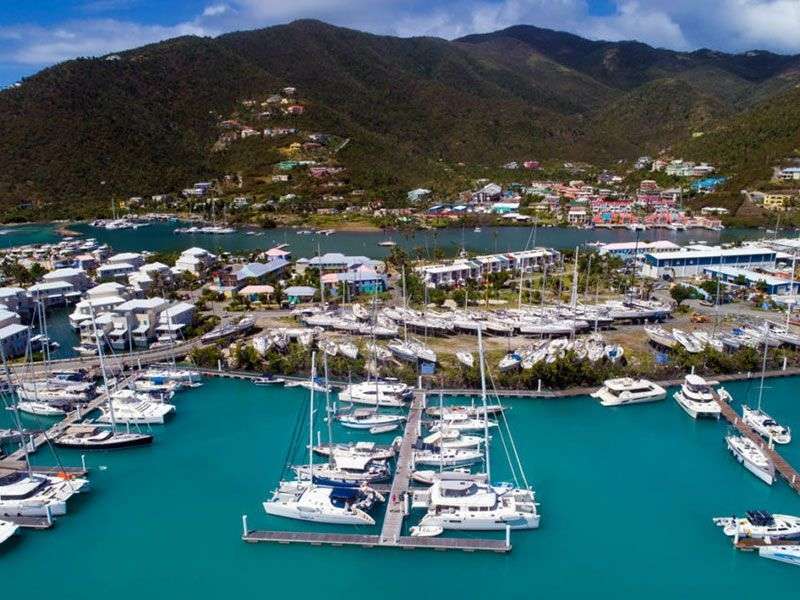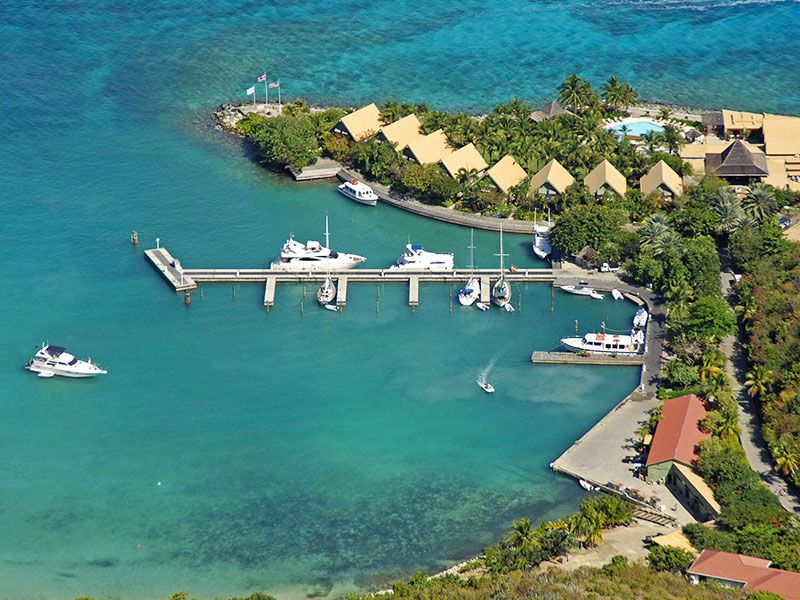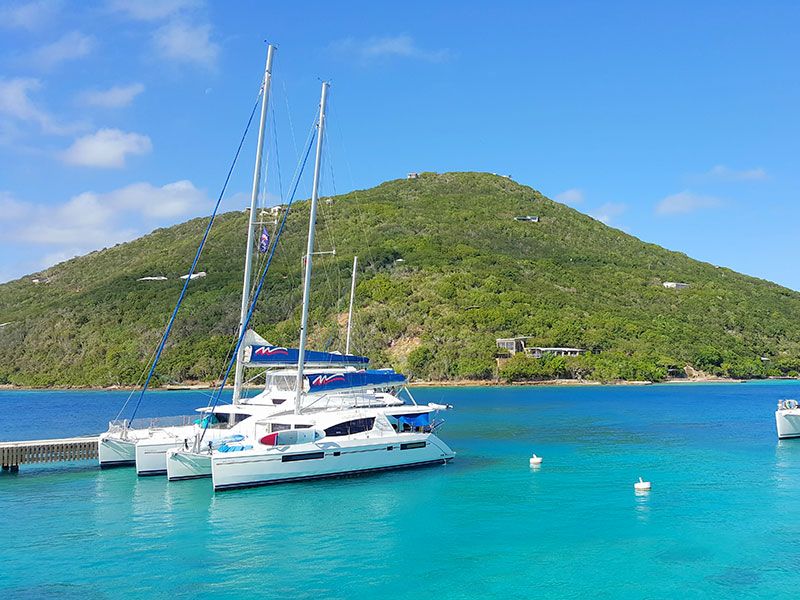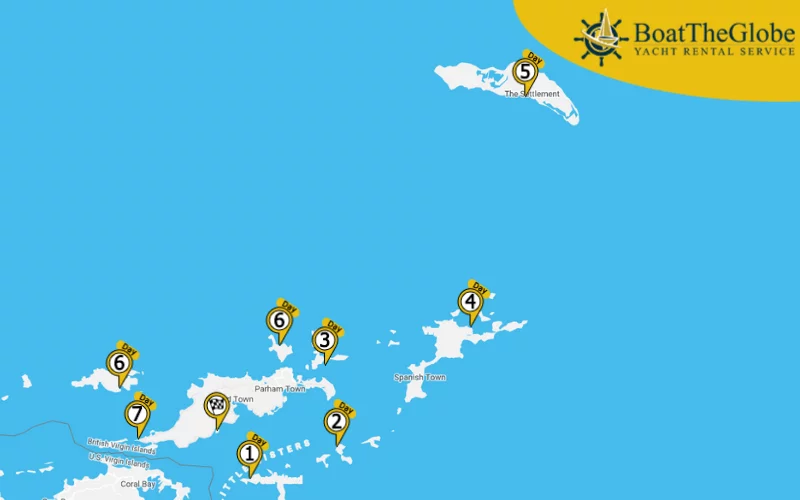Are you planning a sailing trip in Tortola? We help with itineraries, ports, yacht rental options & other useful information. Whether you are only familiarising yourself with sailing or have years of experience, it doesn’t really matter – a holiday on Tortola is truly beyond compare. Tortola is the largest and most populous island of the British Virgin Islands with suitable conditions for sailing during almost the entire year. The temperature and the sea are warm, and the breezes continuously provide refreshment. There are short distances between the ports and islands; our trip will be relaxing and spectacular at the same time. We can expect beautiful beaches, gorgeous diving spots, amazing restaurants, and bars buzzing with life here. Tortola is a real heaven for sailors! We recommend this article to those who are planning their sailing adventure in Tortola to explore the surrounding islands by boat.
This article gives you an overview of the following topics:
- Ports and Islands around Tortola
- The climate of Tortola
- Sail in Tortola! Tortola sailing & catamaran tours:
- 7 days Tortola sailing trip
- A week Tortola catamaran tour
- Marine Gas in Tortola, boat gas stations around BVI
Ports and Islands around Tortola
Tortola is one of the most popular sailing destinations in the world, offering numerous well-equipped marinas not only on the main island but also on nearby smaller islands. Rent a boat in Tortola and enjoy complete relaxation while sailing from one stunning cove to another.
Nanny Cay
Nanny Cay is located on Tortola’s southern coast, just over three kilometers from Burt Point. The marina provides full services, including haul-out, fuel, and electricity access. Nanny Cay Marina offers 320 boat slips, 120 outer and 200 inner, all equipped with fuel and power. Entrance is via a narrow channel, so careful navigation is recommended. Nearby, you’ll find small restaurants, a supermarket, and boutique shops, perfect for a short stroll or provisioning.
Road Harbour
Road Town, the capital of Tortola, is the sailing hub of the British Virgin Islands. Entry is through the Sir Francis Drake Channel. Road Harbour hosts several full-service marinas including Road Reef Marina, Fort Burt, and Wickham’s Cay I and II. These marinas provide over 120 boat slips and are conveniently close to the town center. Many sailors start their BVI adventures from here, making it an ideal base to explore nearby islands and coves.
Fat Hog’s Bay and East End Bay
Fat Hog’s Bay and East End Bay are located on Tortola’s eastern coast near Parham Town. Both bays offer excellent anchorages suitable for overnight stays. Access is via the Sir Francis Drake Channel, with entrance marked by two buoys. Protected behind reefs, the bays provide stable holding. Depths range from 3 to 4 meters. Three marinas are located here: James Young, Penny’s Landing, and Harbour View, offering fuel, water, ice, ATMs, and small shops, making them convenient stops for provisioning.
BVI National Park Trust Moorings
Around Tortola, the BVI National Park Trust has installed 200 surface moorings for a maximum stay of 90 minutes. The system protects marine life and uses color-coded moorings: orange – day use, non-diving boats; white – dive use; blue – boats; yellow – commercial vessels. Moorings can be found at Penn’s Landing, Great Camanoe, Cooper Island, Norman Island, The Indians, and Guana Island. Anchor carefully to avoid damaging fragile coral reefs. If no mooring is available, sand patches can be used. Avoid night sailing for safety.
Peter Island
Peter Island, the fifth-largest BVI island, offers stunning beaches and excellent anchorages. Little Harbor is a small, well-protected cove, while Great Harbour to the east is also suitable for anchoring, though deeper water may require extra caution. On the north side, Sprat Bay hosts Peter Island Resort and Yacht Harbor, offering premium services, while White Bay on the south coast provides quieter anchorages with fewer boats. Ideal for sailors seeking privacy away from main routes.
Marina Cay
Marina Cay is located at Tortola’s eastern end, between Beef Island, Great Camanoe, and Scrub Island. This tiny three-hectare island offers protected anchorages and is easily accessible via the Sir Francis Drake Channel or between neighboring islands. Pusser’s Marina Cay features a restaurant and gift shop, making it a perfect stop for a short visit or relaxing evening.
Maya Cove
Maya Cove, also known as Hodges Creek, is on Tortola’s southeastern coast, west of Buck Island. The area is protected by a reef and cooled by the northeast wind. Entrance is marked by buoys, with a narrow approach channel requiring careful navigation. The marina is busy in peak season, with primary anchoring at the southern end. Hodges Creek Marina offers full services including water and ice. The area features excellent restaurants and beautiful views, ideal for a comfortable stopover.
The climate of Tortola
Tortola has a tropical climate. It is hot during the entire year, but the dominant trade winds somewhat cool the air down. The period between December and March is usually milder, with an average temperature of 24–25° Celsius. It is very hot between May and October: the daily average temperature is around 28° Celsius. The dry period lasts from January to April; the driest months are February and March. You can expect heavy rainfalls from May to December. The hurricane season is from July to October – it brings strong winds and heavy rains. The sea is warm during the whole year, with an average temperature of 27° Celsius. The sailing season is between December and April. During this time, the weather is not so hot and the amount of precipitation is also smaller; there is also a lower risk of tropical storms and hurricanes. The wind is northeasterly during the winter months, then blows towards the east in February and changes its course to the southeast by June. It usually has a velocity of 28–38 km/h, with the exception of the Christmas winds with 50 km/h. The seas are fairly calm. Check the sailing conditions and wind rose diagram of Tortola.
Sail in Tortola! Tortola sailing & catamaran tours:
7 days Tortola sailing trip
During this 7 days sailing trip, we will sail around Tortola while also passing by some smaller islands. We can even get an extra stop during the day. For example, we can navigate to The Indians after Norman Island or sail to Guana Island before getting to Scrub Island. All of these are very exciting places; however, conditions might not always be ideal for night anchorage.
Day 1. Nanny Cay, Tortola – The Bight, Norman Island
9.70 km (6.02 nm)
What makes Norman Island an amazing place is a fact that there are plenty of great docking places here. One of the most popular one among them is the Bight. It is a very well-protected bay located in an idyllic natural environment. It is located on the southern coast of the island. There are app. 75 buoys in the bay and another 17 in the nearby anchoring area. We need to pay the fee to the staff at Pirate’s Bight. The so-called Caves can be found at Treasure Point, at the southwestern corner of the island.
There is vivid sea life here, and the caves with their shallow waters are ideal for an exciting diving experience. Let’s drop anchor and get a drink while floating on the sea and enjoying the peaceful environment of Norman Island!
Day 2. The Bight – Hallovers Bay, Cooper Island
16.35 km (10.16 nm)
There are several anchorages at Cooper Island. It is a very popular spot, so it gets filled with boats quickly. We can anchor at the less-known Hallovers Bay, located a bit to the south from the resort of the island. It is a quieter bay with a large sandy area. There is always a pleasant breeze no these parts; the sea and the beach are also fantastic.
Day 3. Hallovers Bay – Trellis Bay, Beef Island
10.90 km (6.77 nm)
Trellis Bay, located at the eastern corner of Beef Island Tortola is a large and amazing anchorage. The depth of water here is app. 4 to 4.5 metres; the sea bottom is soft and ideal for securing our boat firmly. The tiny island of Bellamy Cay can be found in the centre. The water is fairly shallow around the sandbank, so we must be careful. As the airport of the island has also been established here, there are some special navigation rules.
There is a ‘No go zone’ on the western side beginning at the end of the runway. It is marked by 8 flashing buoys. Yachts with a height of over 3 metres cannot enter this zone, which also needs to be kept free for sailboats. As for boats with a mast higher than 1.5 metres, they need authorisation each time they enter. There are several restaurants and shops on the island, and the famous full moon party of the island is also organised in the bay.
Day 4. Trellis Bay – Scrub Island
2.20 km (1.37 nm)
Scrub Island is located 2.5 kilometres from Tortola. The island is barely 3 kilometres long and has a territory of only 230 hectares. Its centre is Scrub Island Resort Marina. The yacht marina provides 55 deepwater anchorages for both short and long time docking. We can find many good restaurants and shops in the village. There are also different sea tours offering the opportunity to discover the breathtaking sea life of the area. Scrub Island is very close to North Drop where the largest swordfish of the world live.
Day 5. Scrub Island – Cane Garden Bay
18.90 km (11.74 nm)
Cane Garden Bay is an excellent docking place with a beautiful beach on the northern coast of Tortola. It is easy to enter, there is a large area for docking, and we will have a wonderful view of Jost van Dyke. The bay is surrounded by marvellous mountains, and some of the local restaurants entertain their guests with live music. Many sailors consider this the best port.
Day 6. Cane Garden Bay – Jost van Dyke, Great Harbour
10.40 km (6.46 nm)
As the name suggests, Great Harbour is the largest harbour on Jost van Dyke. The area is well-protected thanks to the high mountains. The depth of water is between 5 and 9 metres. We can anchor or use the mooring balls. There are many bars, restaurants, churches and shops ashore, and we can go scuba-diving at an amazing reef nearby.
Day 7. Jost van Dyke – Soper’s Hole – Nanny Cay
18.90 km (11.74 nm)
Soper’s Hole is located at the western end of Tortola. The port has the typical characteristics of the British Virgin Islands. We can enter quite easily, as the entrance is spacious; the confluence is ideal and the port is also well-protected. Soper’s Hole Wharf and Marina is a complex offering all services in one place. They have fuel, water, ice and is a great supermarket here as well, where we can buy anything we need. There is also a marina for dinghies on the western side of Frenchman’s Cay. It is a beautiful place with a colourful design.
Although Irma, the most devastating hurricane of recent times has left its mark on Nanny Cay, if you want to have nice drinks and eat delicious food, you should have a stop here. There are cultic bars waiting for thirsty travellers like the Soggy Dollar Bar. Anyone who is looking for a dance club will also find some awesome places.
A week Tortola catamaran tour
We are going to do a larger distance on this route, navigating from Virgin Goda all the way to Anegada. That is where we will turn back. Anegada is a really unique destination on the British Virgin Islands. Unlike the other islands, this one is challenging to spot from a great distance as it’s quite flat. It’s surrounded by coral reefs, making it more difficult to access it – we should definitely use a navigation device. Even though this trip is quite a challenge, we encourage you to take it! You should plan your trip well in advance though, and leave early as well as in good weather.
Day 1. Nanny Cay – Peter Island, Little Harbor 6.35 km (3.94 nm), Day 2. Peter Island – Manchioneel Bay, Cooper Island 10.70 km (6.65 nm), Day 3. Manchineel Bay – Marina Cay 9.05 km (5.62 nm), Day 4. Marina Cay – Leverick Bay, Virgin Gorda 17.00 km (10.56 nm), Day 5. Leverick Bay – Anegada, The Settlement 24.65 km (15.32 nm), Day 6. Anegada – Guana Island – Jost van Dyke, Little Harbor 51.35 km (31.91 nm), Day 7. Jost van Dyke – West End Tortola – Nanny Cay 16.00 km (9.94 nm)
Read more about BVI sailing
Marine Gas in Tortola, boat gas stations around BVI
- FORT BURT, TORTOLA: Depth: 2 m, GPS Coordinates : 18.412269, -64.613963
- HODGES CREEK, TORTOLA: Depth: 2.5 m, GPS Coordinates : 18.424174, -64.568258
- MANUEL REEF MARINA, TORTOLA: Depth: 2m , GPS Coordinates : 18.407174, -64.631785
- NANNY CAY, TORTOLA: Depth: 3 m, GPS Coordinates : 18.396844, -64.636066
- SOPER’S HOLE, TORTOLA: GPS Coordinates : 18.385014, -64.701245
- PETER ISLAND: Depth: 3.5 m, GPS Coordinates : 18.356766, -64.580064
- GREAT HARBOR, JOST VAN DYKE: GPS Coordinates: 18.442594, -64.753877
- LEVERICK BAY MARINA: Depth: 3 m, Working time: 8–22 GPS Coordinates: 18.497400, -64.385500
If we visit Tortola, we will definitely want to go back several times. There is something really special on this island that is beyond compare – maybe it’s the beauty of the Caribbean Sea, the tropical atmosphere, or the fact that it’s very sailor-friendly. Let’s get on our boat and decide for ourselves what the magic of Tortola lies in! Find last-minute yacht charter BVI, crewed catamaran charter BVI, bareboat catamaran charter BVI, BVI sailing yacht charter bareboat, BVI crewed yacht charter, bareboat yacht charter BVI, BVI luxury yacht charter, yacht rental BVI, catamaran charter BVI, sailboat charter BVI
HELP ME TO CHOOSE THE PERFECT BOAT




